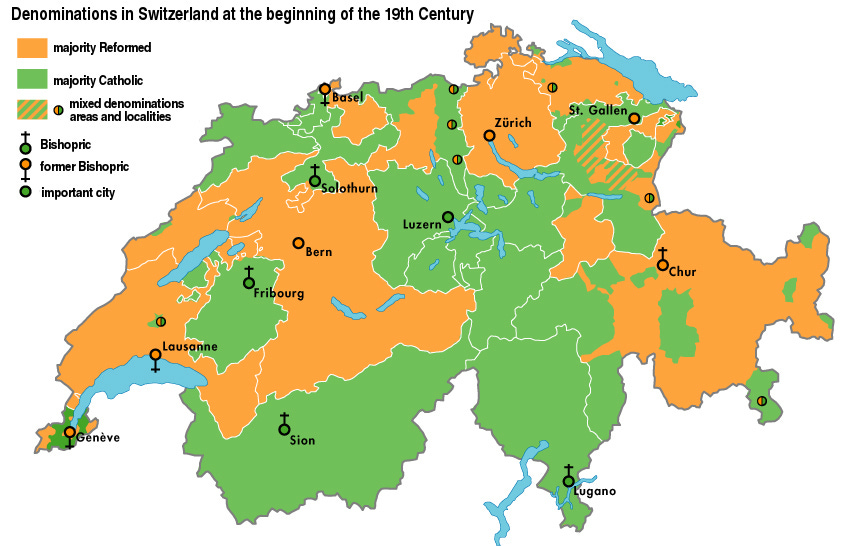A bit of religious history today.
Growing up as a Protestant Christian, what I knew about the religious landscape of Switzerland was through the work of well-known reformers John Calvin (who did much of his work out of Geneva) and Ulrich Zwingli (based out of Zürich). I also knew that Francis Schaeffer spent formative time in Switzerland.
Regardless of your views on these theologians, they were influential nonetheless. So I had the assumption that Switzerland would be a hotspot of Protestant churches with their roots all the way back to the Reformation and beyond.
Turns out, though, I’m actually living in a heavily Roman Catholic canton. The canton of Luzern is one of 7 Catholic cantons, while the 19 others have more Protestant influence. In order to better understand the Catholic influence of Central Switzerland, we must look to the Sonderbund War of 1847.
The Early 1800s
First, let’s set the stage briefly. In the early 1800s, Switzerland was a confederation where each canton (26 total) had a large amount of autonomy, which impacted economy, money, and religion. This made business between cantons and resettling elsewhere increasingly difficult. For an overview of the religions of each canton in that time, see the image below.

https://en.wikipedia.org/wiki/Sonderbund_War
Fast forward to the early 1840’s, and the divide between Protestants (largely liberal, urban bourgeoisie) and Catholics (conservatives) was getting more intense. In 1843 the liberal party drafted a new Swiss constitution, effectively allowing numerous cantons to unify together while also starting to limit the power of the Catholic church (by closing and seizing monasteries).
Naturally, Catholic cantons were opposed to these new measures. 7 specific cantons (Lucerne, Fribourg, Uri, Schwyz, Unterwalden and Zug) banded together to form the Sonderbund and save their freedoms. As they were down in numbers, the Sonderbund turned to additional support from foreign powers Austria and France in 1845. However, the liberal leaders were not fans of that decision, and by 1847 the federal government took action in order to break up these rebellious cantons.
One Month of War

https://en.wikipedia.org/wiki/Sonderbund_War
The civil war itself, Switzerland’s most recent war, was less than a month long, occurring all in November 1847. The ultimate decision was a battle held in Luzern, of all places, which left the Sonderbund on the losing side. Shortly after, in 1848, a new Federal Constitution was born, causing Switzerland to become a modern federal state with restricted cantonal authority.
One point of note is that there were fewer than 100 casualties between both sides. Despite this relatively small number, this war actually helped pave way for the formation of the Red Cross. Guillaume Henri Dufour, the leader of the federal army, ordered his troops to help care for the injured/wounded. Also, when all was said and done, the federal government taxed the two cantons that remained neutral in the war, then sent all of those funds to widows and orphans of the war. A bit odd, I know, but in the years to follow Dufour would help to found the Red Cross.
Maybe you’ll find this short video interesting, as well.
Even though the Catholic Sonderbund cantons came out on the losing side, the influence is still strongly felt today. (One of the benefits for us is that it leads to more observed city/university holidays. Fine by me). For example, even when compared with nearby cities, Luzern still has conservative business hours. Businesses close early on Saturdays, remain closed on Sundays, and are usually closed by 5 or 6 on weeknights (I guess you can’t totally connect early business hours and conservative, Catholic tradition right away, but I’ve heard a few locals tell me that’s the reason, so it’ll suffice for now).
So yes, I’ll admit, I was super surprised to learn of the Roman Catholic influence where I’m living. I just didn’t expect it.
But oh well, I suppose that’s part of the reason that we learn about other places.
*Here are some sources I used…gotta be scholarly…


